Piccalilli is probably one of Britain's favourite pickles, also know as mustard pickle. Crunchy vegetables in a sauce thickened with cornflour and laced with turmeric, mustard powder and other spices.

It's not certain where piccalilli originated. It has been suggested that piccalilli is the English interpretation of Indian pickles. This sounds plausible given the ingredients, in particular English mustard powder, and the spicing.
This old fashioned pickle recipe is a mix of vegetables, pickled with spices. It's adapted from Pam's piccalilli recipe from River Cottage. Delicious served with crusty bread, cold cuts and a cheeseboard. Piccalilli is ideal over Christmas time as there is an abundance of cheese, ham and other cold cuts and it pairs perfectly.
I find that making this easy piccalilli recipe around October means it's ready just in time for Christmas. Not only great with your Christmas cheeseboard, and to enjoy with leftovers, it also makes the perfect foodie gift for family and friends.
Why you'll love this recipe
- The perfect balance of flavours with just enough mild spice and sweetness to balance out the sourness in this easy pickle.
- Stores well, you can prepare this mustard pickle and store it, unopened, in a cool, dark place for up to 1 year.
- A versatile pickle that can be used with cheese, cold cuts, or in salads and sandwiches.
- Homemade pickles like this easy mustard pickle, make great foodie gifts for family and friends.
Piccalilli ingredients
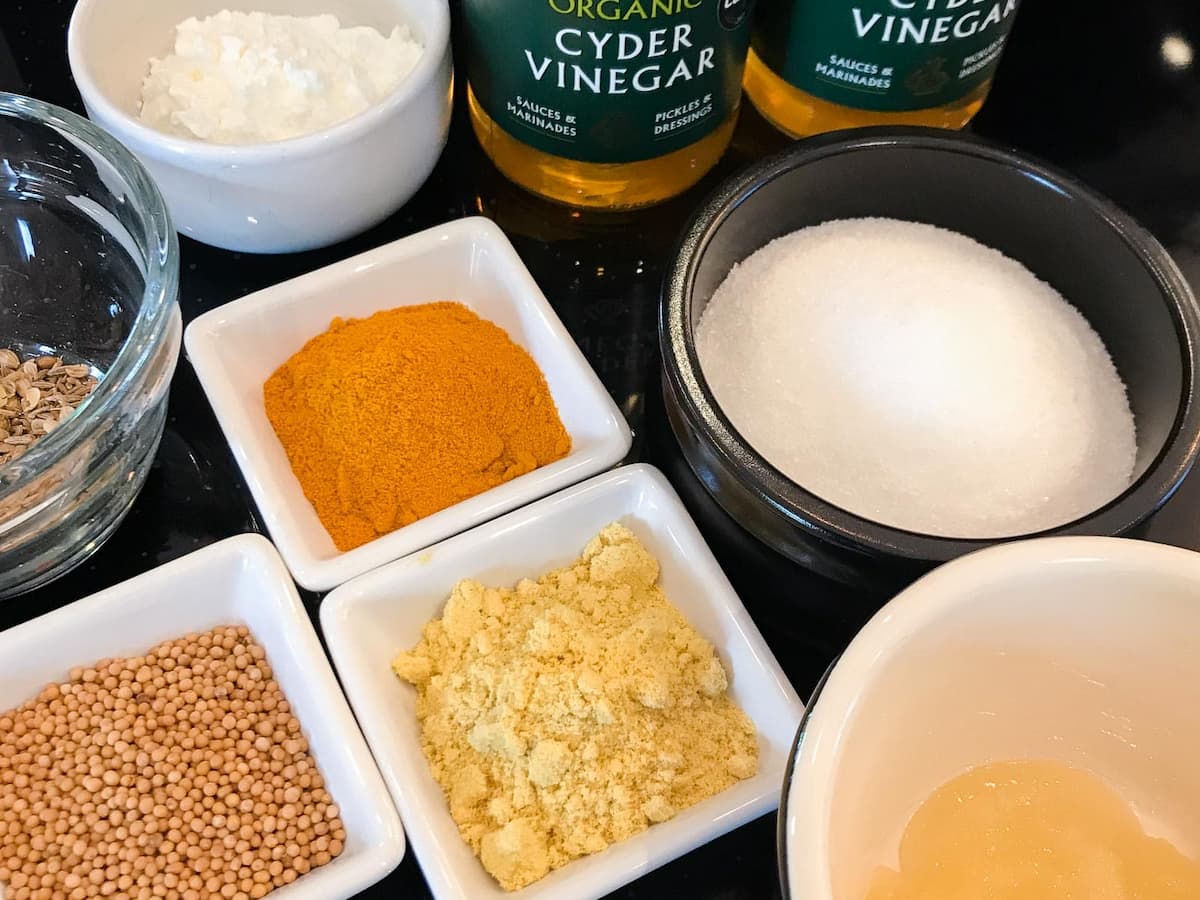
- Vegetables - I use 1 kilo of mixed vegetables, usually selected 5-6 vegetables, and always including onion and cauliflower.
- Salt - I use fine sea salt to salt the vegetables which helps to draw out excess moisture, leaving you with crunchy vegetables.
- Cornflour - is added to the spice paste to thicken it, helping to coat the vegetables.
- Spices - I like to use combination of English mustard powder, yellow mustard seeds, cumin seeds, coriander seeds and ground turmeric for that vibrant yellow colour we all associated with piccalilli.
- Vinegar - I use apple cider vinegar in this recipe as it adds a lovely flavour.
- Sweetener - I like to use a combination of honey and regular granulated sugar to sweeten the spice paste.
How to make piccalilli
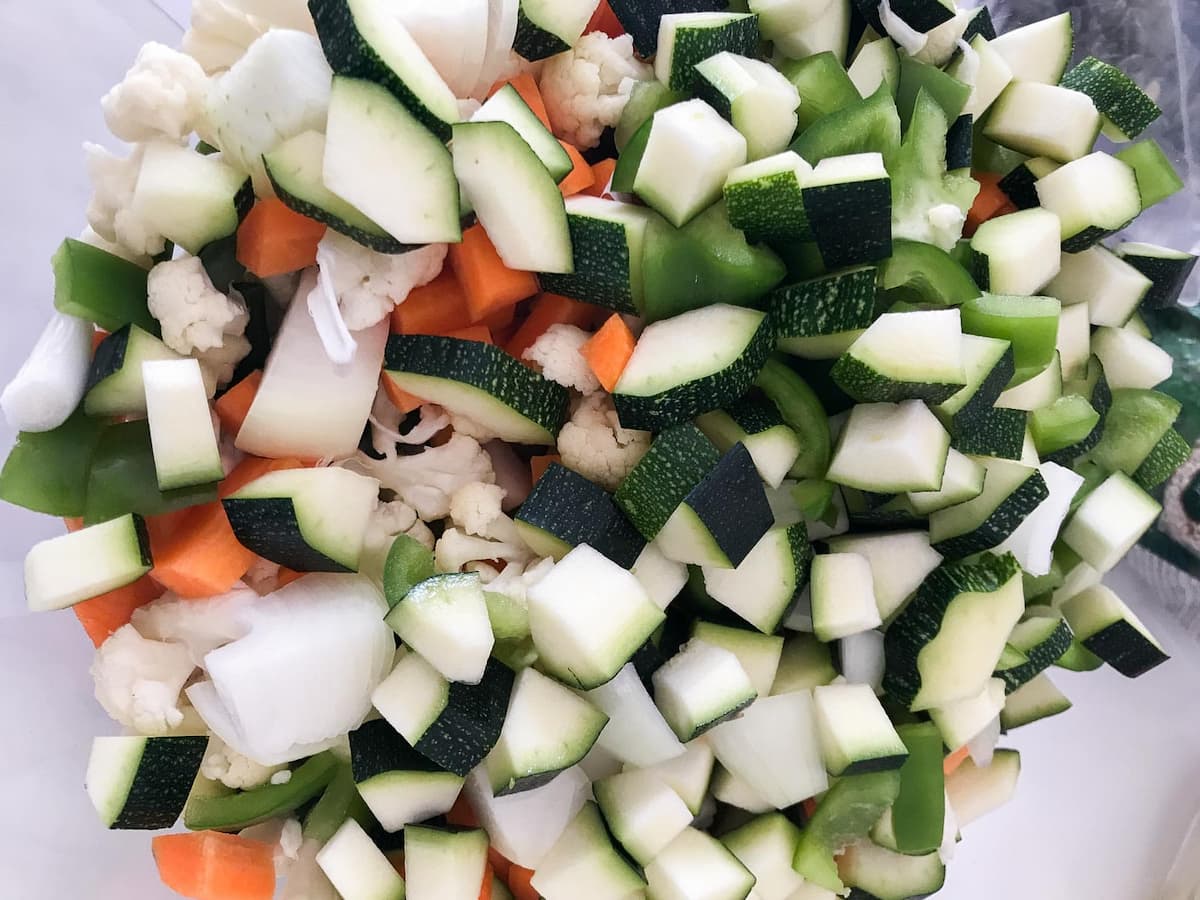
- Cut the vegetables into small, even bite-sized pieces.

- Place the vegetables into a large colander (or sieve) set over a large mixing bowl. Add the vegetables to the colander, sprinkle with salt and stir to combine.
- Cover with a tea towel and set aside in a cool place for 24 hours. This process draws they excess water from the vegetables, leaving you with crunchy vegetables.
- Now thoroughly rinse the vegetables under cold running water to remove any excess salt. Take time to do this and ensure the salt has been completely rinsed off.
TOP TIP: I prefer to use my large salad spinner as it allows me have a basket in which the moisture can drip from. If you don't have a spinner then a sieve used over a large bowl and covered with a tea towel works just as well.
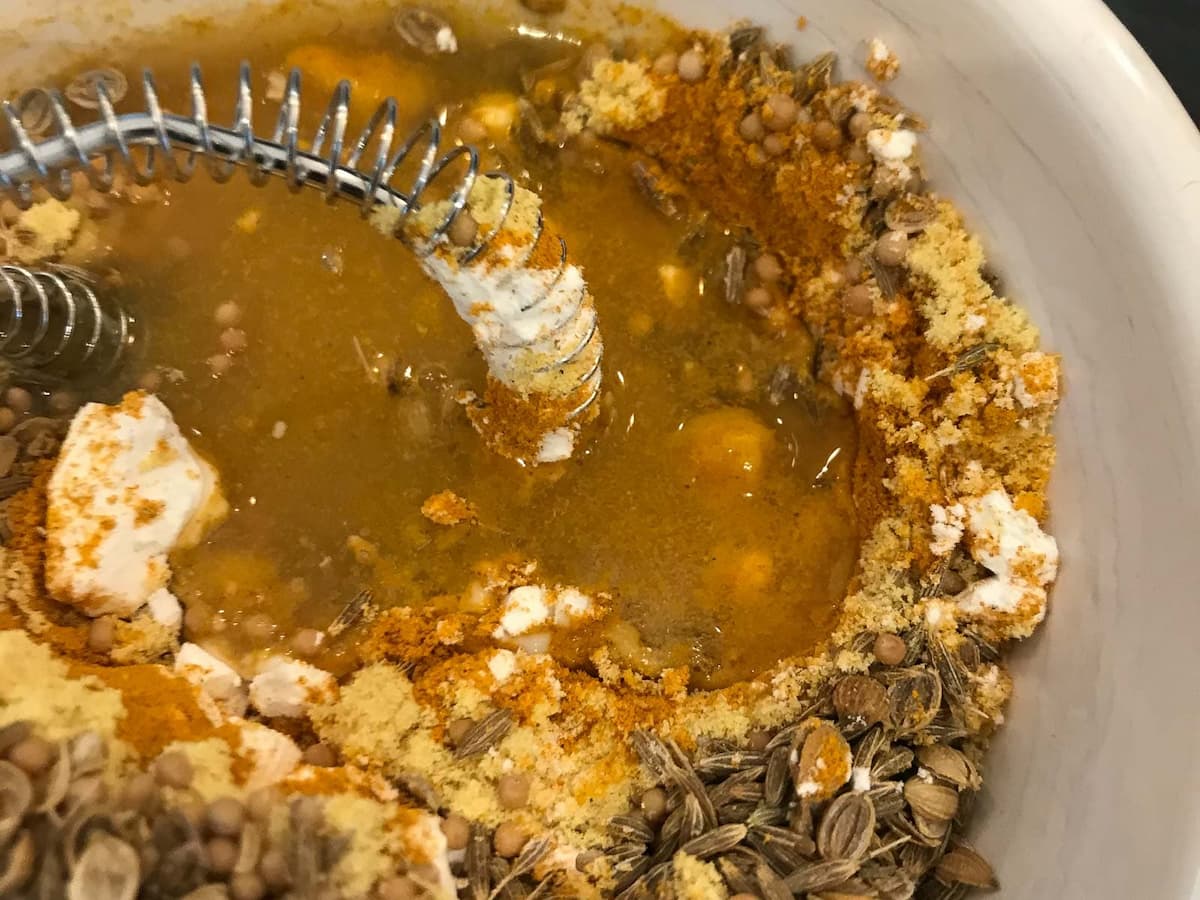
- Place the cornflour, turmeric, mustard powder, mustard seeds, cumin and coriander onto a bowl with a little of the vinegar, and stir well to form a paste.
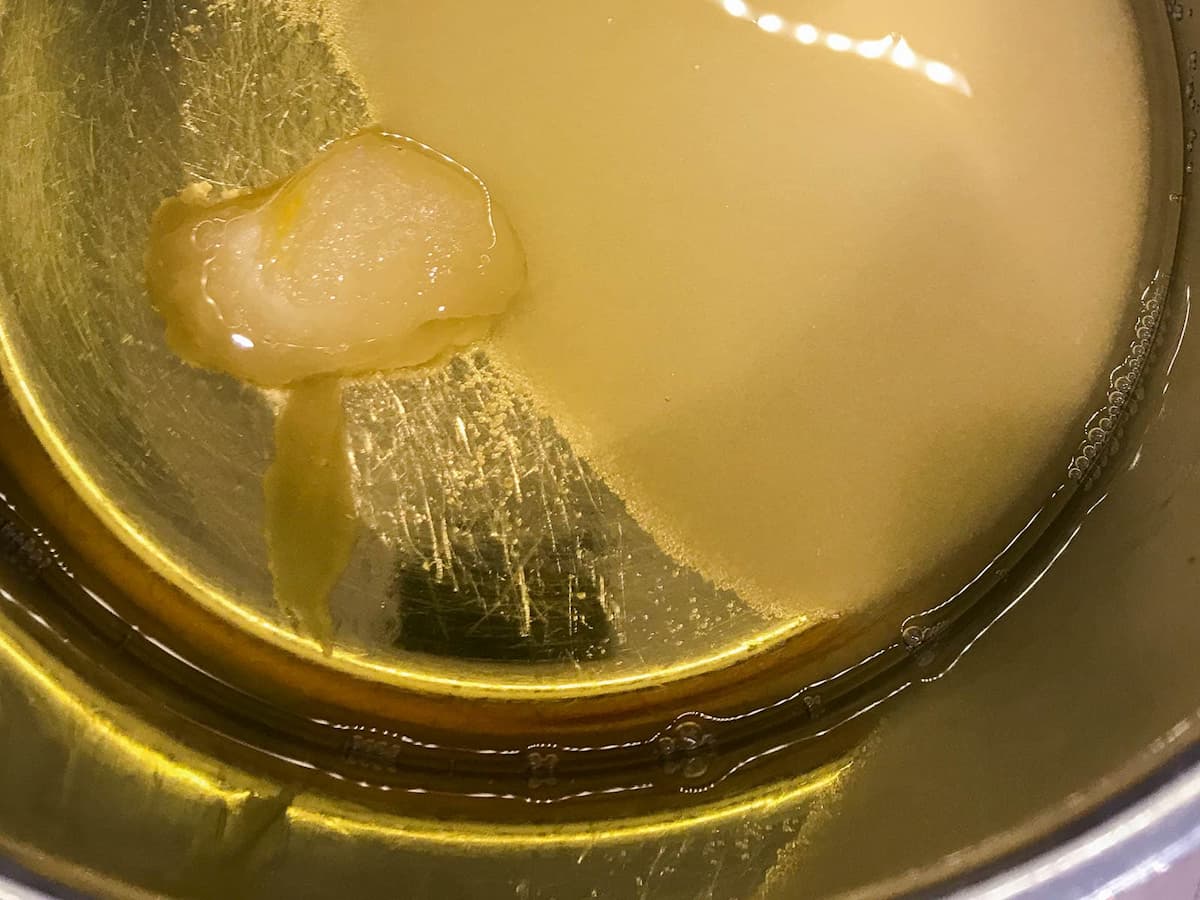
- Place the remaining vinegar into a saucepan with the sugar and honey and bring to the boil.

- Pour a little of the hot vinegar over the blended spice paste, stir well and return this paste to the pan. Gently bring to a boil and boil for 3–4 minutes to allow the spices to release their flavours into the sauce.
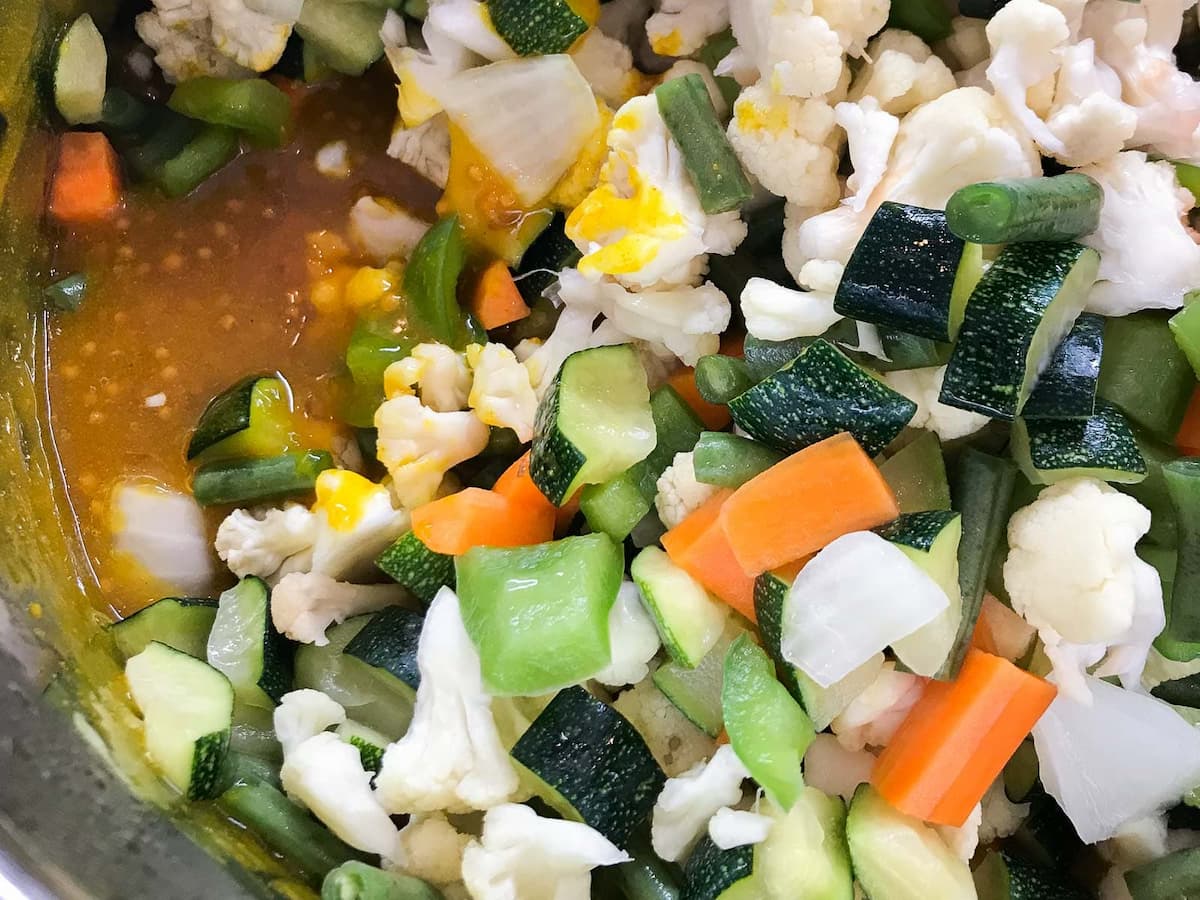
- Remove the pan from the heat and carefully fold the well-drained vegetables into the hot, spicy sauce.
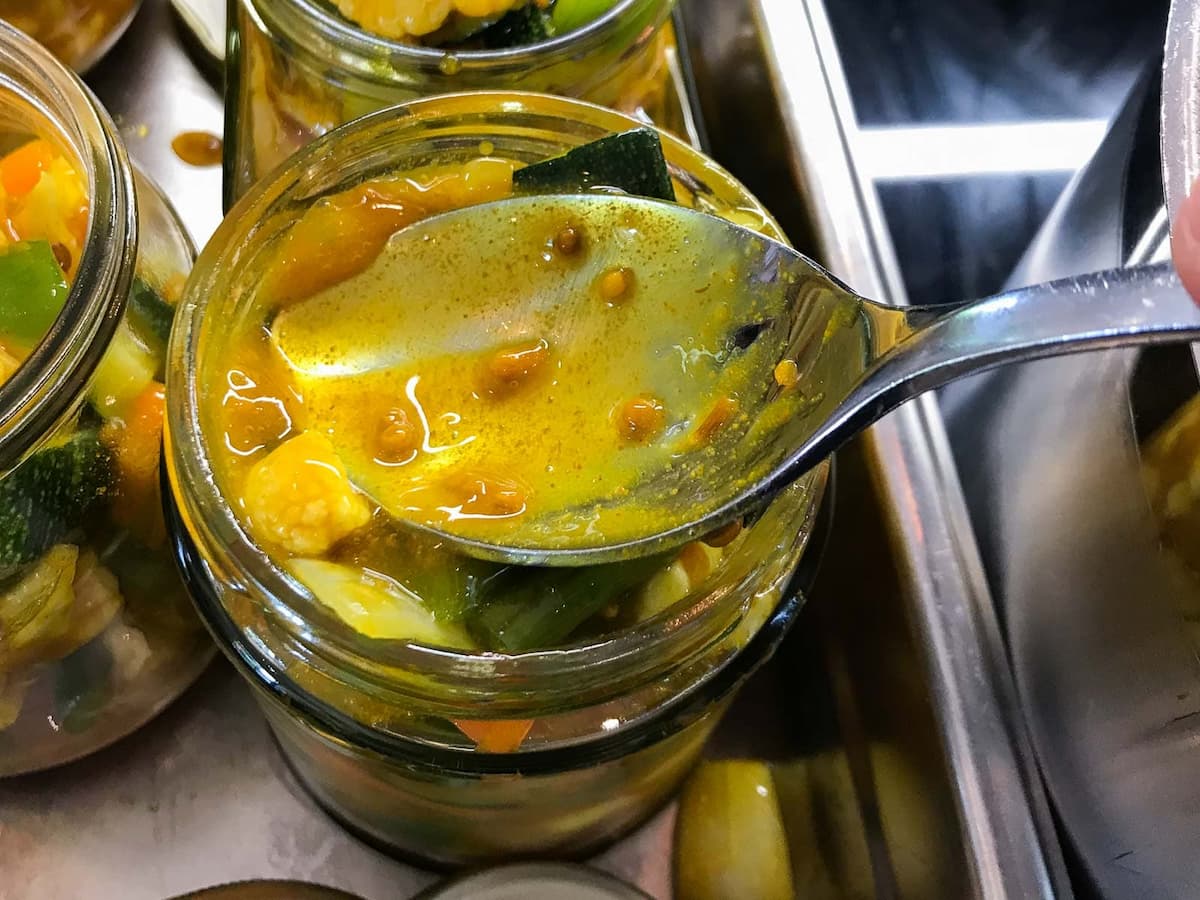
- Pack the pickle into warm, sterilised jars and seal immediately with vinegar-proof lids.
TOP TIP: Fill the jars and push the vegetables in with the back of a spoon. The less air in the jars the better and longer they will keep unopened.
How to sterilise jars?
For information on sterilising the jars you can check my Apple Jelly post for more details on how to do this.
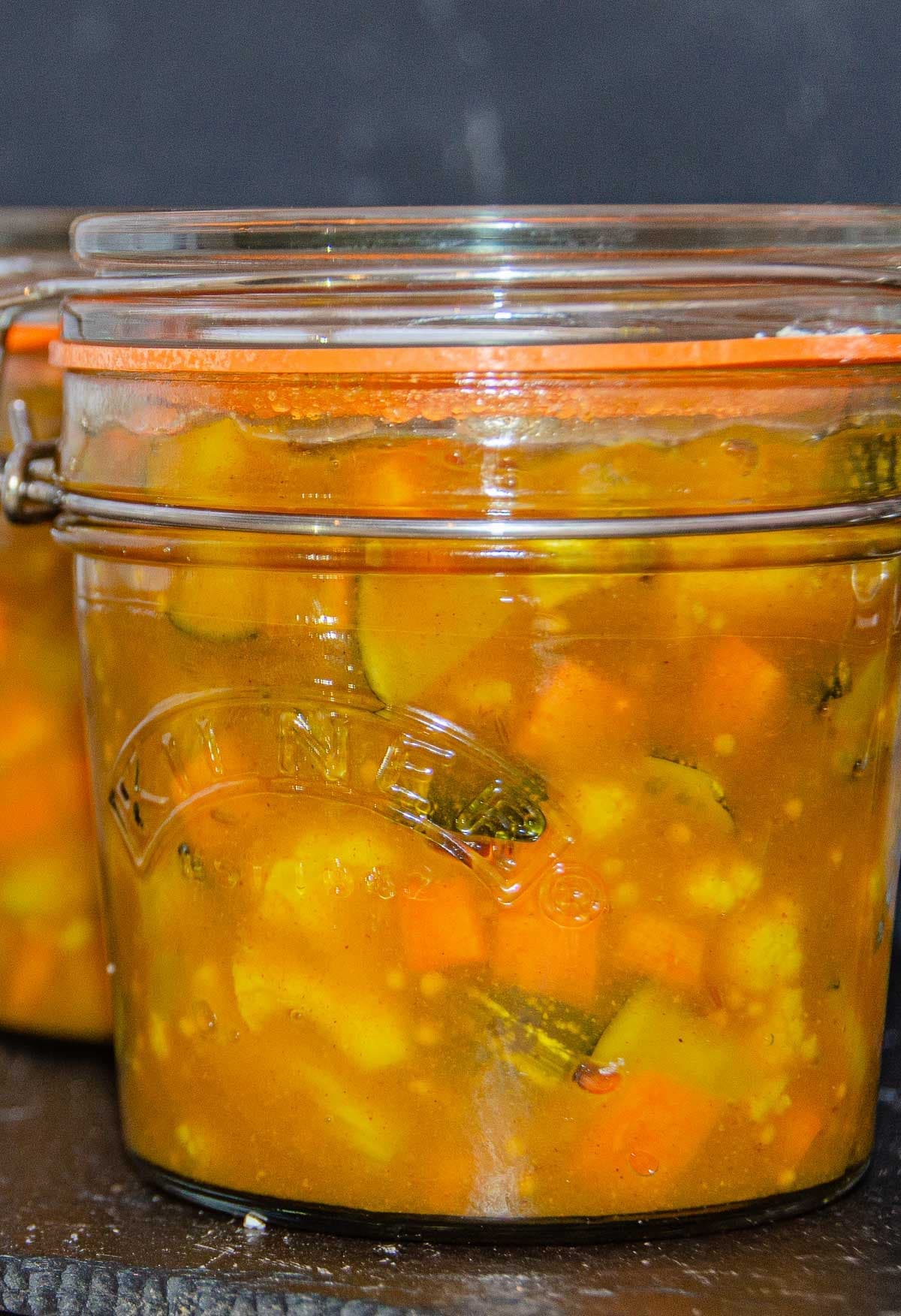
- Set aside in a cool, dark place and leave for 4–6 weeks before opening. Use within a year.
TOP TIP: While its tempting to use these straight away, a pickle like this takes time for the flavours to infuse into the vegetables. At this stage it will taste "vinegary" and not balanced. Set it aside to sit for 4-6 weeks and it will taste a whole lot better!
Recipe variations
- Vegetables - you can adapt the vegetables you used, depending on what you enjoy eating and have in the fridge at home. I always use cauliflower and onion, along with a mix of other vegetables. I will often add green beans, carrots, any colour pepper, shallots.
- Cauliflower - in the past I've swapped cauliflower for Romanesco cauliflower.
- Courgette - I like to use courgette rather than cauliflower, not only do I grow in my garden, but I also prefer the firmer texture.
- Spices - you can adapt the spicing to taste, but don't miss out the turmeric which gives piccalilli it's wonderful yellow colour.
- Mustard - I use English mustard powder as it has a lovely strong flavour. You could swap for a Dijon mustard if you really don't like the flavour of strong English mustard.
- Vinegar - I like to use apple cider vinegar, but white wine would be a good alternative.
- Honey - for a vegan piccalilli swap honey for maple syrup.
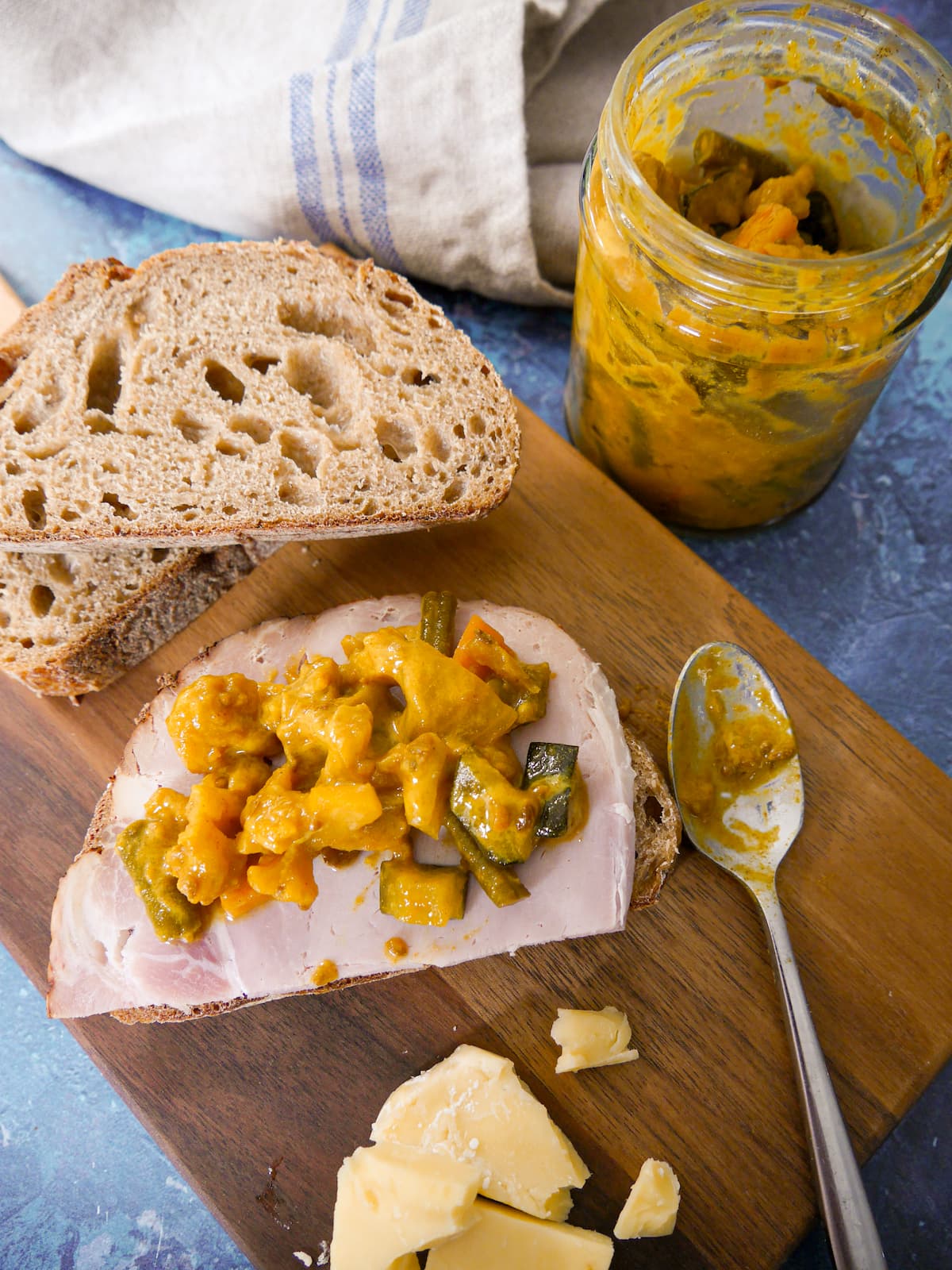
Serving suggestions
Serve this delicious vegetable pickle in a variety of different ways. It's great with a cheeseboard or with cold cuts of meat, think Boxing day ham or leftover turkey!
I love to enjoy piccalilli on open sandwiches, or in place of regular pickle in a cheese and pickle sandwich. You can also add it to salads, it's a really versatile pickle.
Useful hints and tips
- Take time cutting the vegetables into bite sized pieces. Sounds tedious but when serving you want to have small bites rather than large chunks of vegetables.
- You must salt the vegetables! Missing this important step will leave you with excess moisture in the jars and soggy vegetables, not appetising at all. Salting draws out the water, leaving you with crunchy vegetables.
- When draining the vegetables use a large sieve or colander set over a large bowl. This allows the liquid to drain off the vegetables, and avoids them sitting in salty water. If you have a large salad spinner that would work well here too.
- Take time to properly wash the vegetables to remove any excess salt. Nobody will thank you for overly salty pickle.
- Check the mustard powder to ensure it's gluten free if serving to coeliacs or gluten free diners.
- Containing no dairy this side dish is suitable for dairy free diners.
- Make vegan piccalilli by swapping honey for maple syrup.
- Allergy advice: gluten free, dairy free, egg free, soya free and nut free. For comprehensive and detailed allergy advice go to Allergy UK.
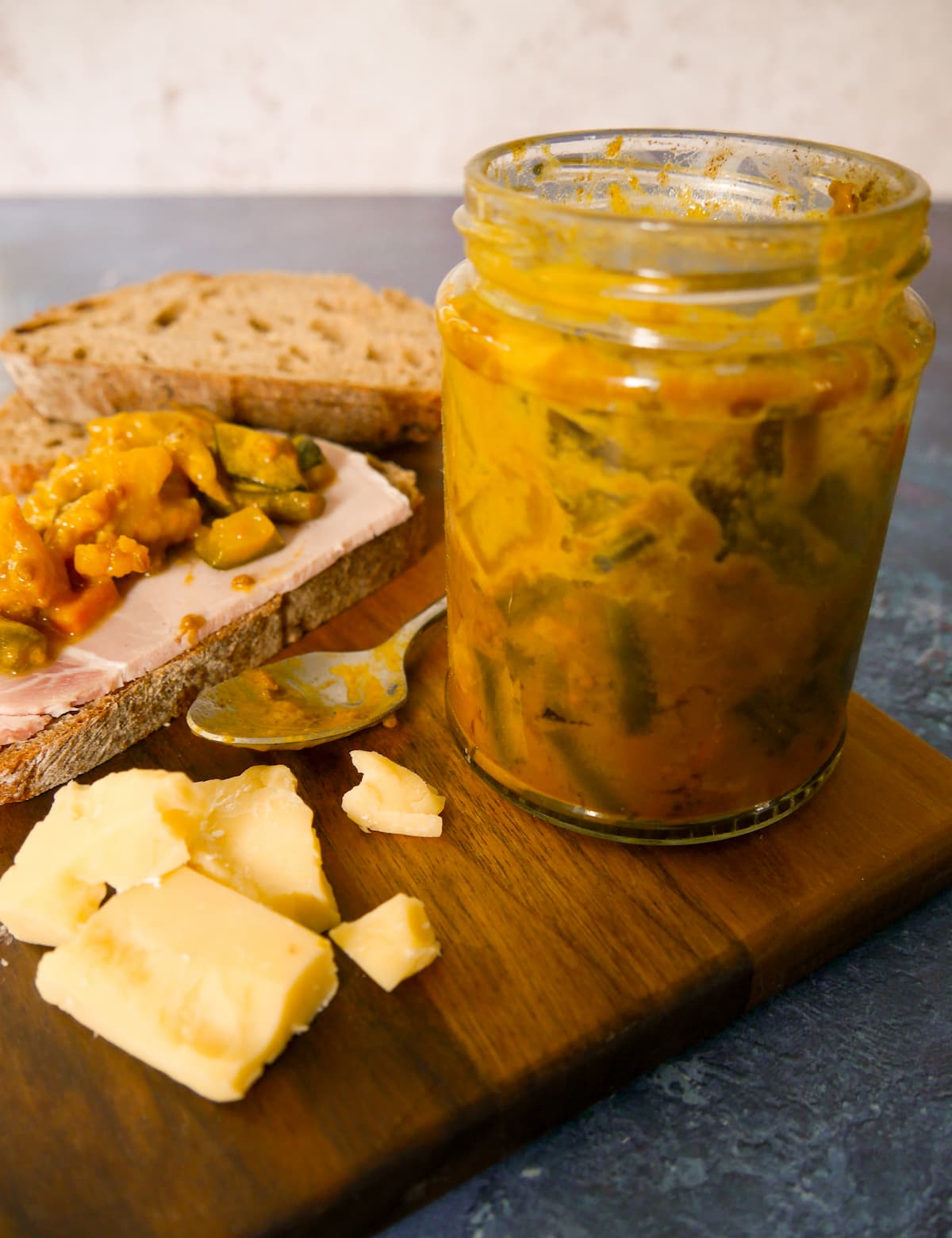
FAQs
Traditional piccalilli uses cauliflower florets, cucumber, onions and green beans. While I sometimes stick to those vegetables, each year my batch varies depending on what I have growing in the garden. But I always include cauliflower and onion.
Homemade piccalilli is a great way to use small amounts of vegetables that would otherwise be wasted. You can choose to adapt the vegetables to what you prefer. I use courgettes instead of cucumber as I grow my own. I have used Romanesco broccoli in the past, along with ordinary broccoli instead of green beans.
You can make piccalilli at any time of the year. However, piccalilli is always on my mind in October when I am at the end of my vegetable growing season, making it an ideal time to be ready for the Christmas cheeseboard and leftover roasted meats!
Allow the jars to sit in a cool, dark space for at least 4-6 weeks before opening. I always label pickles with the date it's made and the date it will be ready to enjoy. Once a jar has been opened store in the refrigerator for 1-2 months. Unopened jars can be stored in a cool, dark space for up to 1 year.
Yes, pickled vegetables, like this piccalilli, contains beneficial bacteria which support our microbiome and are therefore great for gut health.
Pin the recipe

Additional recipe suggestions
If you like this recipe then try some of my other easy preserve recipes:
- Spiced Plum Chutney
- Spiced Pear & Apple Chutney
- Pear & Walnut Chutney
- Quick Courgette & Shallot Pickle
- Quick Pickled Radishes
- Summer Pickled Vegetables
- Spicy Sweet Chilli Jam
- Mulled Pears

Pam's Piccalilli (from River Cottage)
Equipment
- chopping board
- Sharp kitchen knife
- Vegetable peeler
- Colander
- large bowl
- Saucepan
- measuring spoons
- Large spoon for mixing
- 4 Sterilised jars
Ingredients
- 1 kg mixed vegetables (wash & peel vegetables – select 5 or 6 from the following: cauliflower or romanesco cauliflower; green beans; cucumbers; courgettes; green or yellow tomatoes; carrots; small silver-skinned onions or shallots; peppers)
- 50 g fine salt
- 30 g cornflour
- 10 g ground tumeric
- 10 g English mustard powder
- 15 g yellow mustard seeds
- 1 teaspoon crushed cumin seeds
- 1 teaspoon crushed coriander seeds
- 600 ml cider vinegar
- 150 g granulated sugar
- 50 g honey
Instructions
- Cut the vegetables into small, even bite-sized pieces.
- Place the vegetables into a large colander (or sieve) set over a large mixing bowl. Add the vegetables to the colander, sprinkle with salt and stir to combine.
- Cover with a tea towel and set aside in a cool place for 24 hours. This process draws they excess water from the vegetables, leaving you with crunchy vegetables.
- Now thoroughly rinse the vegetables under cold running water to remove any excess salt. Take time to do this and ensure the salt has been completely rinsed off.
- Place the cornflour, turmeric, mustard powder, mustard seeds, cumin and coriander onto a bowl with a little of the vinegar, and stir well to form a paste.
- Place the remaining vinegar into a saucepan with the sugar and honey and bring to the boil.
- Pour a little of the hot vinegar over the blended spice paste, stir well and return this paste to the pan. Gently bring to a boil and boil for 3–4 minutes to allow the spices to release their flavours into the sauce.
- Remove the pan from the heat and carefully fold the well-drained vegetables into the hot, spicy sauce.
- Pack the pickle into warm, sterilised jars and seal immediately with vinegar-proof lids.
- Set aside in a cool, dark place and leave for 4–6 weeks before opening. Use within a year.
Notes
• Please note that the nutrition information provided above is approximate and meant as a guideline only •

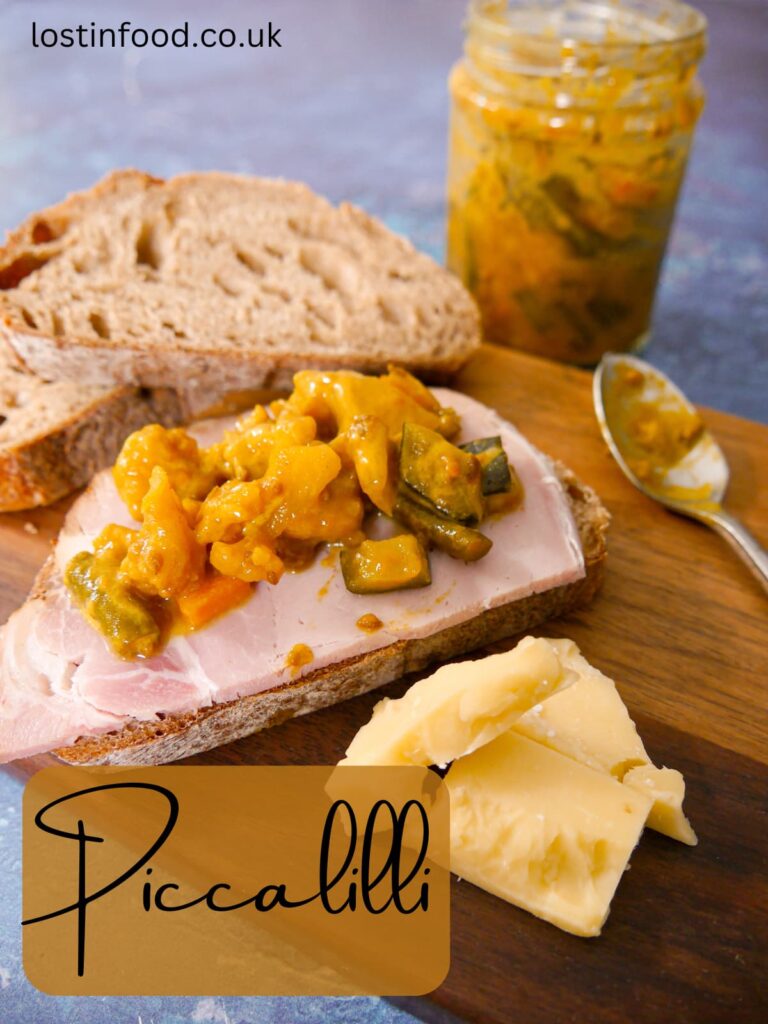
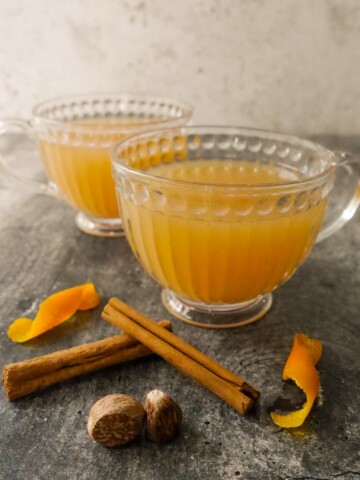
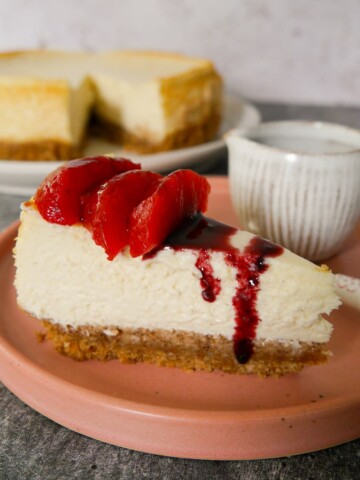

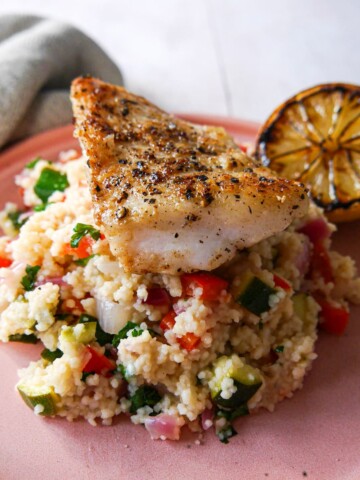
Jane MacDonell says
On to my 4th batch, amazing recipe, thank you
Lesley says
Thank you Jane, it really is a great recipe and one I make all the time at home.
John Tillott says
Best recipe ever, followed recipe to the t, cannot fault it, made two lots, firstly as per your recipe, then as I had some sweetend malt vinegar left over after doing some pickled onions thought I would give it a try with that, yummy to both.
Lesley says
Thank you John, I'm glad you've found the recipe. I've used this recipe myself for years and find it always turns out well, regardless of what combination of vegetables I use.
Margaret Hoyle says
Originally from Yorkshire so am delighted to find this recipe.
Being just one person can i half this recipe? if so how much will it make and how long will it keep.
Thank you
Margaret Hoyle.
[email protected]
Lesley says
Hi Margaret, I'm happy to help. Yes, by all means half the recipe, that will give you roughly 2 jars depending on the size of jars you are using. I always store any jams or preserves in a sterilised jars, in a dark space out of sunlight. Stored like this they will keep for up to a year. Piccalilli should be stored for 6 weeks before you try it, that will allow the flavours to really meld together. Once a jar is open please store in the fridge and use within 6-8 weeks. I hope this helps. Lesley
Derek Wales says
Hi,
Does anyone make a picslilli with more cauliflower in it. Ones I have tried seem very short of cauliflower which I like.
Thank you
Derek
Lesley says
Hi Derek, what I like about this recipe is that you can adapt it to suit your own tastes. Like you I love cauliflower and tend to add more of that and a little less of say the green beans.
Melinda Ghirardi says
Hi there, my vegetables are soaking ready to make this picallili recipe tomorrow. If I want to make a bulk batch with 2kg of vegetables, do I double up the sauce ingredients?
Lesley says
Melinda, my apologies for the delay in getting back to you, I was away this weekend. I would also double up on the sauce ingredients, you may have a little left over, but better that than not enough to coat the vegetables.
Sarah says
I made this, and it turned out a little too thick so next time might reduce the cornflour. However the saltiness was extreme!!!! I rinsed and soaked and rinsed but things like the courgette I just could not get it out of. I didn’t notice in the recipe about suspending the bowl so guess that’s what I did wrong. I also used purple cauliflower which looked amazing but has now turned all the jars red!!!
Lesley says
Hi Sarah, yes it is really important that you suspend the vegetables over a bowl, that way the excess salty water will drain away. You can also use a salad spinner if you have one. Thank you for pointing this out though, I will amend the recipe and ensure this is really clear. And yes, using any purple or red coloured vegetables will colour everything else in the mix, beetroot, red onions and red cabbage are exactly the same, they turn everything red!
Dudley says
This must be my favorite picalilli recipe. Making it in bulk for gifts this Xmas. Don't chance a thing....
Lesley says
Thank you Dudley, it's certainly one of the most popular recipes on our site and it makes a great gift at Christmas.
Dean says
Looking forward to making your picalilly. I assume the salt in the recipe is just used for drawing water out of the veg and not added to the cooking mixture? The nutrition label gives a high % of salt?
Lesley says
Thank you for pointing this out Dean, you are of course quite right and the salt is only to draw the water out of the veg, before it is then washed away. I really appreciate this comment and I will now go and amend the nutritional label so that it reads properly. Meantime, I hope you enjoy the piccalilli, it's a favourite recipe of ours.
Dean says
Your recipe produced excellent picalilly. Today I am going into mass production for Christmas. . Thank you.
Lesley says
Thank you very much Dean, I'm glad you liked the recipe. I use it all the time and it is really reliable.
Chris Akroyd says
My go to piccalilli recipe.
I do use 50g of cornflour and an extra spoonful of honey as I like mine very thick and sweet.
Great depth of flavour and you taste all the spices in waves.
The honey also adds a superb extra level and I'm not a great honey fan, but it works so well with this recipe, so don't substitute it for sugar
I am one for adding extra spices, chilli etc to everything, but in this case it's not needed
Cannot be beaten with good fresh baked bread, butter and home baked ham and a nice pint of bitter
Michelle says
I agree Chris, a great recipe. Love the ability to add those little changes to make things your own and to your own taste. Cheers, Michelle
Eb Gargano | Easy Peasy Foodie says
Such a lovely recipe = perfect for gluts of home-grown produce! Eb x
Lesley says
Thank you Eb, it certainly proves very popular in our homes, perfect with a cheeseboard and some cold cuts. Lesley
Cat | Curly's Cooking says
What a great way to use homegrown vegetables to make a delicious pickle. Such an amazing colour and this would be a fantastic addition to any cheeseboard!
Lesley says
Thank you Cat, I love this pickle, it's great on a cheeseboard and the colour is beautifully vibrant. Lesley
Jacqui – Recipes Made Easy:Only Crumbs Remain says
I know a lot of people who are fans and I do sometimes make it for friends. Thank you for sharing on #CookBlogShare
Lesley says
Thank you Jacqui, it makes a great foodie gift for friends with a nice cheeseboard. Lesley
Magdalena says
It's good to know that you can use different vegetables with this recipe - we have a glut of veggies from our friend's allotment and this recipe will be great to use.
Lesley says
Thank you Magdalena, this is a great recipe for using up a glut of vegetables, it's ideal when you can pickle and preserve when you have too much. Lesley
Chloe Edges says
Well Pan certainly send to know what she's doing doesn't she! The colour of picalilli is always so wonderful, this is clearly no exception.
Lesley says
Thank you Chloe, piccalilli is a real treat, I love the colour and it is great on a cheeseboard! Lesley
Janice Pattie says
This piccalilli is so good. It’s a great recipe and really easy to make.
Lesley says
Thank you Janice, it's certainly a lovely pickle and one we both enjoy eating. Great on a cheeseboard, with some cold cuts. Lesley
Lorraine Smith says
Brilliant recipe saw it today on the show & im going to try it out thank you